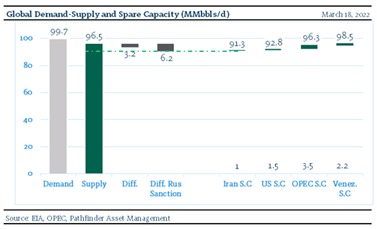Portfolio Diversification and Commodities
Continuing with our commodities theme, we look at oil. Oil has seen a lot of press recently as concerns regarding global production grow due to Russian sanctions from the Ukraine conflict, and correspondingly oil prices have risen and remain highly volatile. How meaningful are Russian sanctions from an investor’s standpoint?
While it is very hard to predict with any type of certainty, let’s look at overall demand and supply. Both OPEC and EIA provide data and short-term forecasts on the production of oil. As of the end of December 2021, demand (~99.7MMbbls/d) likely outpaced supply by about 3.2MMbbls/d. This gap is expected to be maintained somewhat throughout 2022 and this is helping drive oil prices higher. Russian sanctions could impact up to 3MMbbls/d, or 30% of Russian production (66% of their export volumes), which would put the demand-supply differential roughly at 6.2MMbbls/d. This differential could have significant consequences for oil prices.

Russia’s pipeline capacity to the west-supporting countries is approximately 3MMbbls/d. Assuming Russia can’t re-route some of their sanctioned oil friendly markets, then the 3MMbbl/d will need to be replaced by other countries.
OPEC has roughly 3.5MMbbls/d of spare oil capacity. Iran could provide 1MMbbls/d of production if the US were to lift sanctions, but this might not be real spare capacity due to Iranians likely skirting the sanctions. Venezuela previously produced closer to 3MMbbls/d, but is currently at 790kbbls/d. However, it might take months or years to get to that capacity for OPEC and Venezuela.
“This means that” if Russian sanctions are implemented long-term on the fully exposed 3MMbbls/d, within a year the world could have reasonably recovered a significant portion of the missing production. But between disciplined drilling in North America and questionable spare capacity elsewhere, it might take longer. Our view is that the underlying fundamentals of oil, regardless of sanctions, remains very strong in the near term 1-2 years and Russian sanctions are less meaningful than other fundamental drivers, contrary to what headlines may have us believe.
National Instrument 31-103 requires registered firms to disclose information that a reasonable investor would expect to know, including any material conflicts with the firm or its representatives. Doug Johnson and/or Pathfinder Asset Management Limited are an insider of companies periodically mentioned in this report. Please visit www.paml.ca for full disclosures.
*All returns are time weighted and net of investment management fees. Returns from the Pathfinder Partners’ Fund and Partners’ Real Return Plus Fund are presented based on the masters series of each fund. The Pathfinder Core: Equity Portfolio and The Pathfinder Core: High Income Portfolio are live accounts. These are actual accounts owned by the Pathfinder Chairman (Equity) and client (High Income) which contain no legacy positions, cash flows or other Pathfinder investment mandates or products. Monthly inception dates for each fund and portfolio are as follows: Pathfinder Core: Equity Portfolio (January 2011), Pathfinder Core: High Income Portfolio (October 2012) Partners’ Fund (April 2011), Partners’ Real Return Plus Fund (April, 2013), and Partners’ Core Plus Fund (November 2014).
Pathfinder Asset Management Limited (PAML) and its affiliates may collectively beneficially own in excess of 10% of one or more classes of the issued and outstanding equity securities mentioned in this newsletter. This publication is intended only to convey information. It is not to be construed as an investment guide or as an offer or solicitation of an offer to buy or sell any of the securities mentioned in it. The author has taken all usual and reasonable precautions to determine that the information contained in this publication has been obtained from sources believed to be reliable and that the procedures used to summarize and analyze such information are based on approved practices and principles in the investment industry. However, the market forces underlying investment value are subject to sudden and dramatic changes and data availability varies from one moment to the next. Consequently, neither the author nor PAML can make any warranty as to the accuracy or completeness of information, analysis or views contained in this publication or their usefulness or suitability in any particular circumstance. You should not undertake any investment or portfolio assessment or other transaction on the basis of this publication, but should first consult your portfolio manager, who can assess all relevant particulars of any proposed investment or transaction. PAML and the author accept no liability of any kind whatsoever or any damages or losses incurred by you as a result of reliance upon or use of this publication.